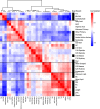Systemic alterations in the metabolome of diabetic NOD mice delineate increased oxidative stress accompanied by reduced inflammation and hypertriglyceremia
- PMID: 25852003
- PMCID: PMC4451288
- DOI: 10.1152/ajpendo.00019.2015
Systemic alterations in the metabolome of diabetic NOD mice delineate increased oxidative stress accompanied by reduced inflammation and hypertriglyceremia
Abstract
Nonobese diabetic (NOD) mice are a commonly used model of type 1 diabetes (T1D). However, not all animals will develop overt diabetes despite undergoing similar autoimmune insult. In this study, a comprehensive metabolomic approach, consisting of gas chromatography time-of-flight (GC-TOF) mass spectrometry (MS), ultra-high-performance liquid chromatography-accurate mass quadruple time-of-flight (UHPLC-qTOF) MS and targeted UHPLC-tandem mass spectrometry-based methodologies, was used to capture metabolic alterations in the metabolome and lipidome of plasma from NOD mice progressing or not progressing to T1D. Using this multi-platform approach, we identified >1,000 circulating lipids and metabolites in male and female progressor and nonprogressor animals (n = 71). Statistical and multivariate analyses were used to identify age- and sex-independent metabolic markers, which best differentiated metabolic profiles of progressors and nonprogressors. Key T1D-associated perturbations were related with 1) increases in oxidation products glucono-δ-lactone and galactonic acid and reductions in cysteine, methionine and threonic acid, suggesting increased oxidative stress; 2) reductions in circulating polyunsaturated fatty acids and lipid signaling mediators, most notably arachidonic acid (AA) and AA-derived eicosanoids, implying impaired states of systemic inflammation; 3) elevations in circulating triacylglyercides reflective of hypertriglyceridemia; and 4) reductions in major structural lipids, most notably lysophosphatidylcholines and phosphatidylcholines. Taken together, our results highlight the systemic perturbations that accompany a loss of glycemic control and development of overt T1D.
Keywords: diabetic mice; inflammation; metabolomics; oxidative stress.
Figures




Similar articles
-
Diabetes Associated Metabolomic Perturbations in NOD Mice.Metabolomics. 2015 Apr;11(2):425-437. doi: 10.1007/s11306-014-0706-2. Metabolomics. 2015. PMID: 25755629 Free PMC article.
-
Comprehensive Metabolomics Study To Assess Longitudinal Biochemical Changes and Potential Early Biomarkers in Nonobese Diabetic Mice That Progress to Diabetes.J Proteome Res. 2017 Oct 6;16(10):3873-3890. doi: 10.1021/acs.jproteome.7b00512. Epub 2017 Aug 29. J Proteome Res. 2017. PMID: 28799767
-
The association of specific metabolites of lipid metabolism with markers of oxidative stress, inflammation and arterial stiffness in men with newly diagnosed type 2 diabetes.Clin Endocrinol (Oxf). 2012 May;76(5):674-82. doi: 10.1111/j.1365-2265.2011.04244.x. Clin Endocrinol (Oxf). 2012. PMID: 21958081
-
Role for oxidative stress in the regeneration of islet beta cells?J Investig Med. 2004 Jan;52(1):45-9. doi: 10.1136/jim-52-01-25. J Investig Med. 2004. PMID: 14989369 Review.
-
Animal models of spontaneous autoimmune disease: type 1 diabetes in the nonobese diabetic mouse.Methods Mol Biol. 2007;380:285-311. doi: 10.1007/978-1-59745-395-0_17. Methods Mol Biol. 2007. PMID: 17876100 Review.
Cited by
-
Integrating bioinformatics approaches for a comprehensive interpretation of metabolomics datasets.Curr Opin Biotechnol. 2018 Dec;54:1-9. doi: 10.1016/j.copbio.2018.01.010. Epub 2018 Feb 6. Curr Opin Biotechnol. 2018. PMID: 29413745 Free PMC article. Review.
-
Metabolomics and Integrative Omics for the Development of Thai Traditional Medicine.Front Pharmacol. 2017 Jul 18;8:474. doi: 10.3389/fphar.2017.00474. eCollection 2017. Front Pharmacol. 2017. PMID: 28769804 Free PMC article. Review.
-
Chemical Similarity Enrichment Analysis (ChemRICH) as alternative to biochemical pathway mapping for metabolomic datasets.Sci Rep. 2017 Nov 6;7(1):14567. doi: 10.1038/s41598-017-15231-w. Sci Rep. 2017. PMID: 29109515 Free PMC article.
-
Association of the lipidome with type 1 diabetes and the mediated effect of metabolites: A Mendelian randomization study.Medicine (Baltimore). 2025 Jun 13;104(24):e42755. doi: 10.1097/MD.0000000000042755. Medicine (Baltimore). 2025. PMID: 40527788 Free PMC article.
-
Western diet consumption by host vertebrate promotes altered gene expression on Aedes aegypti reducing its lifespan and increasing fertility following blood feeding.Parasit Vectors. 2024 Jan 6;17(1):12. doi: 10.1186/s13071-023-06095-3. Parasit Vectors. 2024. PMID: 38184590 Free PMC article.
References
-
- Abu-Lebdeh HS, Barazzoni R, Meek SE, Bigelow ML, Persson XM, Nair KS. Effects of insulin deprivation and treatment on homocysteine metabolism in people with type 1 diabetes. J Clin Endocrinol Metab 91: 3344–3348, 2006. - PubMed
-
- Baumann B, Salem HH, Boehm BO. Anti-inflammatory therapy in type 1 diabetes. Curr Diabet Reports 12: 499–509, 2012. - PubMed
-
- Benjamini Y, Hochberg Y. Controlling the false discovery rate: a practical and powerful approach to multiple testing. J Royal Stat Soc B (Methodological) 289–300, 1995.
-
- Bolton EE, Wang Y, Thiessen PA, Bryant SH. PubChem: integrated platform of small molecules and biological activities. Ann Rep Comput Chem 4: 217–241, 2008.
Publication types
MeSH terms
Grants and funding
LinkOut - more resources
Full Text Sources
Other Literature Sources
Medical
Miscellaneous

